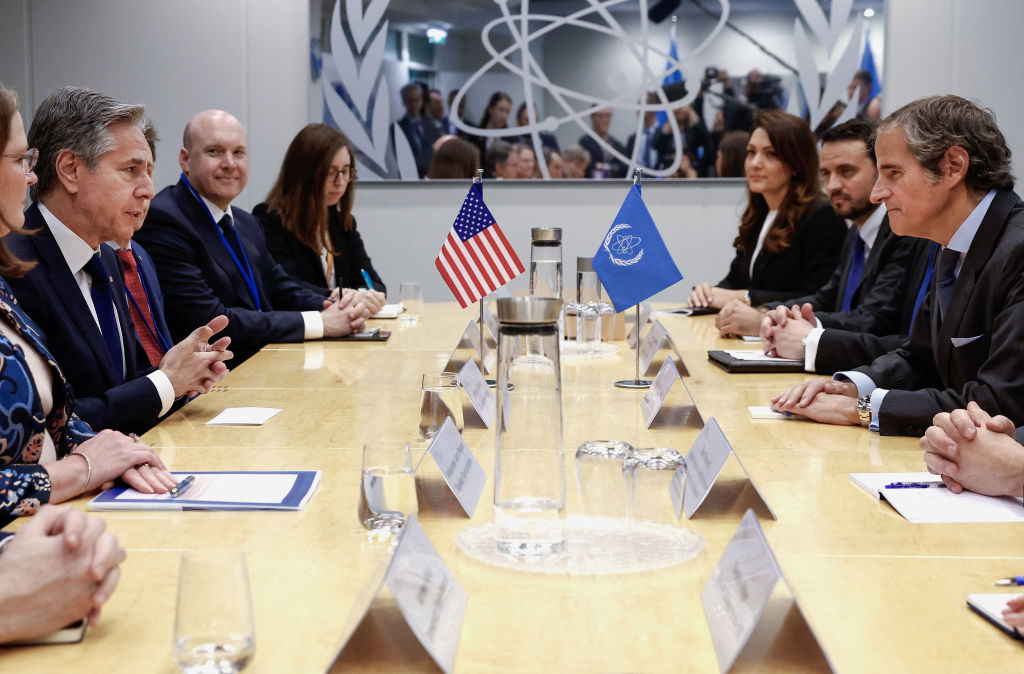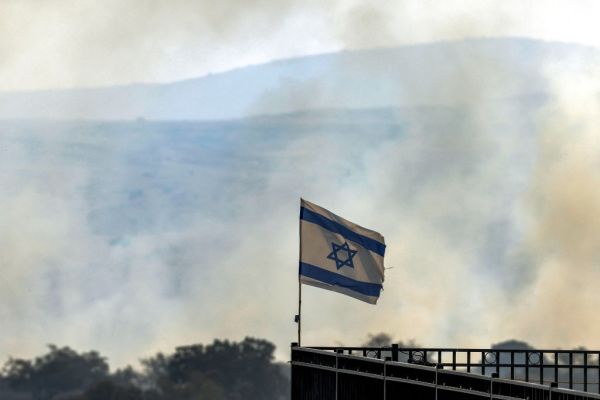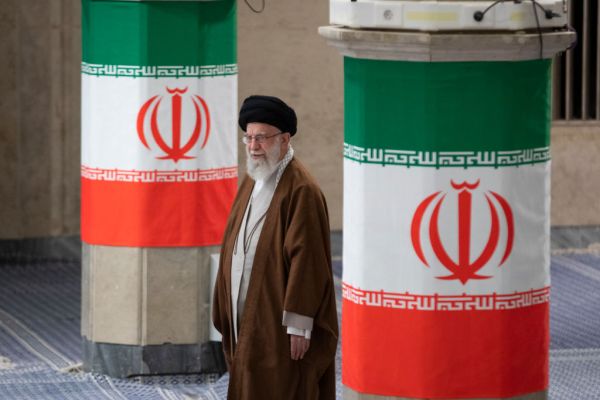The Biden administration still speaks of “not allowing” Iran nuclear weapons. Yet just last Friday, Secretary of State Antony Blinken remarked that Iran is “probably one or two weeks away” from “having breakout capacity to produce fissile material for a nuclear weapon.” His blunt observation, that “where we are now is not a good place,” barely begins to capture the problem.
Thanks to more than a decade of international inaction, Iran’s nuclear program is now so advanced, resilient, and opaque that it can cross the threshold more easily than we can stop it. This accrues deterrence to Iran, reducing its need for any provocative final steps to produce an actual weapon and rouse a global response.
The U.S. has for too long relied on timeworn sanctions and military threats, or simply avoided the issue altogether, eroding our credibility and distracting from an overdue, hard-nosed reevaluation of how Iran has profoundly magnified the costs, risks, and uncertainties of our prevention policy. Until we face up to these failures, Iran increasingly will throw its weight around as if it has nuclear weapons, ramping up its destabilizing aggression that has been so evident since October 7.
Enriching uranium to weapons-grade purity of 90 percent is a longstanding U.S. redline. But Iran has produced so much material just under this line, for so long, as to leave a distinction without a difference between its actions and U.S. prohibitions. Secretary Blinken’s recent comment about Iran being just a week or two from breakout capacity should not obscure the bigger concern: Iran can make a dozen bombs’ worth of 90 percent uranium in just three months and maintain steady output thereafter; the Manhattan Project worked overtime for a year-plus to make just four such quantities. Even if Iran does nothing to expand its infrastructure, these numbers will keep shifting in its favor as stockpiles accumulate. The fact Iran is known to be so close to this threshold, and that any final steps could come quickly and imperceptibly, basically forces the world to treat it like a nuclear power—even when it isn’t.
Iran’s program is also highly resilient. Having seen Iraqi and Syrian nuclear ambitions devastated by small surprise Israeli attacks, Tehran uses new centrifuges to enrich uranium faster at smaller sites that are easier to bury, hide, and disperse. The Stuxnet cyberattack in 2010 set back Iran’s main plant for months, but 10 years later a rash of covert kinetic strikes (attributed to Israel) prompted a much more dangerous response as the regime swiftly boosted uranium output, deployed better centrifuges, shifted enrichment deeper underground, and built new subterranean facilities.
All of this steady progress shrinks the window for inspectors to track ever more activities, which Iran compounds by systematically denying them access. International Atomic Energy Agency (IAEA) Director Rafael Grossi has warned he lost sight of Tehran’s progress long ago and would have to build a new inspections regime from scratch, including on Iran’s weaponization status. Israel’s heist of Iran’s nuclear archives in 2018 showed that to be more advanced than was widely thought, and woven into a maze of military and purportedly civilian sites.
Tehran’s implausible deniability is advantageous. The regime is not overtly completing a bomb, but it knows how to make an advanced version of the implosion-type device used on Nagasaki, and it watched Pakistan successfully test similar designs six times in 1998. Nor would the regime need testing to assure the usability of a simpler gun-type device, like the one used on Hiroshima. Either way, it could produce the components separately and defer assembly, just as the atomic bombs dropped on Japan were finished in the Pacific only days before. Accordingly, leading analysts noted, “it is not possible to predict when or if the Iranian regime might decide to build nuclear weapons” (emphasis added).
This unpredictability helps deter U.S. or Israeli military action. It curbs the ability to gauge whether Iran is about to achieve the bomb, clouds assessments of what damage a strike could or did inflict, and denies success to any ensuing operations. Iran’s missiles and drones reinforce this deterrence by exploiting adversaries’ lack of strategic depth, and holding hostage their bases and other key assets. Iran can credibly threaten massive and precise retaliation, and it expands the range of these weapons by giving them to proxies encircling the region. The cost-benefit analysis of U.S. or Israeli military action favors Iran much more today than when Israel came closest to striking in 2010-12.
Now outmaneuvered, U.S. strategy is slipping into a tacit, but tectonic, shift from preventing to containing or outright ignoring the problem. Six straight administrations have pledged to use all elements of U.S. power to keep Iran from the bomb, but the Biden administration has mixed explicit rejection with implicit acceptance.
Already in spring 2021, American officials admitted aloud their fading hopes to reverse Iran’s advances or divulge its bomb-building efforts. The president and Secretary Blinken each acknowledged this failure privately in late 2022, after Iran ditched JCPOA reentry talks. But it fell to Gen. Mark Milley, then chairman of the Joint Chiefs of Staff, to admit the failure publicly, if not plainly, when he told the Senate last year that the United States would not permit Iran a “fielded” nuclear weapon. By punting a well-established redline beyond the point a bomb could be fully assembled, that single added word spoke volumes about how Tehran was undoing decades of U.S. prevention policy.
In parallel, Iran worked around Prime Minister Benjamin Netanyahu’s 2012 redline of one bomb’s worth of 20 percent uranium. Ten years later, after Tehran produced multiple such quantities, Israelis warned about not enriching above 60 percent—a stance since adopted by the JCPOA’s European parties (The U.K., France, and Britain, known as the E3). This impinges Israeli credibility and gives far less warning time of a much larger breakout.
Tehran’s success is evident in America’s policy catatonia. The United States and E3 have clear authority to “snap back” stringent international sanctions but have refrained from using it. In tandem, President Joe Biden conspicuously avoided his long-promised pivot to a pressure campaign, trying instead to bribe Tehran handsomely to slow, not stop or reverse, a fraction of its enrichment. The administration also quietly restrained Israeli military preparations, driven by transparent aversions to what this portended. Combined with the sheer scale of work required to ready a strike, and Israel’s resulting reticence to deal with Hamas or Hezbollah before the shock of October 7, this shows Iran’s real leverage from its nuclear advances.
Tehran and its proxies underlined this problem by firing the first shots on all seven fronts that now embroil U.S. and Israeli forces in the region’s tensest standoff in a generation. Iran’s audacious targeting of Israel in April with the largest projectile offensive in history, including missiles whose variants could one day carry nuclear warheads, would have been unthinkable if it felt it could not deter or defeat any ensuing conflict spiral. Though tactically impressive, America’s role in helping shoot down that attack, and immediately framing the result as a “win,” actually reinforces Iran’s boldness by conveying an overriding desire to forestall an Israeli response.
In the backdrop, Iranian officials underline their newfound escalation dominance by indicating a readiness to weaponize, if need be—a marked departure from prior excoriations of anyone who questioned the ostensibly civilian nature of their nuclear project. In January, Iran’s nuclear chief declared “it is about us not wanting to do this. It is not about the lack of capability. ... I think we have achieved such deterrence.” The next month, his predecessor said, “We’ve crossed all the lines, overcome all obstacles. It’s like having all the parts to build a car: we have the chassis, the engine, the transmission, everything. Each component serves its purpose, and everything is in our hands.” In April, the security head for nuclear facilities warned: If Israel “wants to use the threat of attacking our country’s nuclear sites as a tool to put Iran under pressure, revision of the Islamic Republic’s nuclear doctrine and polices … is conceivable and probable.”
Anymore, the concern is less how regional tensions create diversions for Iran to cross the nuclear threshold, and more how its capacity to do so compels its enemies to comply with its terms for war and peace. In a damning indictment of this cumulative policy failure, it is best to start anew and stop devaluing America’s word with yet more immaterial promises. Policymakers will have to figure out, from whole cloth, what they are trying to prevent and what it would take to achieve this.
Any cogent answer must first resolve the ambiguity at the core of Iran’s atomic venture and its ability to advance in obscurity. The U.S. can only hope to draw viable redlines, and devise credible threats to uphold them, if it actually knows what’s inside the black box. Thus Tehran first has to provide a complete declaration of its nuclear program, something it roundly rejected when that program was smaller and more vulnerable. This endeavor goes far beyond even the heavy lifting of reconstituting the IAEA’s “continuity of knowledge” about Iran’s declared activities at its handful of known sites, which are just a shrinking fraction of its larger enterprise. The world needs its first-ever full transparency on Iran’s sprawling weaponization drive, enrichment and centrifuge infrastructure, proliferation networks, and missile development. Inspectors then need to be able to verify Iran’s declaration, and anything they suspect is omitted, when and where they choose, including sensitive Iranian military bases, for as long as necessary.
Accordingly, the baseline ultimatum should be that Iran provide this visibility and swiftly comply en toto with the IAEA’s investigation. Only then will it be feasible to reposition and redefine strictures around Iran’s nuclear program itself. Anything else will be drawn in the dark, devoid of credibility. Given Tehran’s tendency to proceed obliquely and in obscurity, this will be more complex than old redlines that could be drawn literally in one stroke, like when Netanyahu famously stood before the U.N. in 2012 and dragged a big red marker across a cartoon explosive representing one bomb’s worth of 20 percent uranium. It may entail Iran rolling back its program from where it now stands, making enforcement even dicier than prior redlines premised on potential future progress.
In this context, Iran would have to, at minimum, adhere to the most stringent IAEA safeguards regime, which means shuttering all undeclared facilities, building no new ones, and comprehensively disclosing its bomb-making efforts. Since inspectors will find rampant Nonproliferation Treaty violations, redlines might need to cut to the quick, as far down as zero enrichment. Forcing Iran to open its books could obviate some of these challenges by also forcing the United States, Israel, and E3 to finally agree on a unified position.
Starting with basic transparency, these redlines will be viable only if Tehran fears significantly more military and diplomatic pressure than it ever has before. Targeting its nuclear and retaliatory capability, and even threatening to do so, is a categorically tougher proposition today than Israel’s strikes on Iraq, Syria, and nearly Iran in 2012 (before America balked). It means the largest U.S. operation since at least the Gulf Wars, and one that promises to be equally open-ended and indeterminate.
Credibly threatening to bring so much force to bear if Iran tests our new redlines, and blunting Iran’s response, necessitates greatly enhanced U.S. force posture in the region. It also entails tight coordination on offensive operations with Israel, at levels that both countries have been loath to undertake, and which increasingly intertwines with Israel’s calculus toward Iran’s most potent proxy, Hezbollah. The United States already faces competing crises in Europe and Asia, unlike 10 to 15 years ago, making it harder to sacrifice readiness elsewhere and secure global allies’ support for another major Middle East conflict.
All this capability will still be moot without U.S. readiness to use it, should Iran dare test new redlines. Four straight commanders-in-chief have failed to convey such intent, which now may include threatening the regime itself, in order to compel it to concede a complete declaration of its program, coerce it to adhere to new redlines, and dissuade it from resuming nuclear work after a potential strike. The United States and E3 also need Tehran to know they will reimpose U.N. sanctions on its illegal nuclear activities in lieu of a complete and verifiable declaration. Reasserting this lost credibility is innately difficult, and made harder still by Iran’s sense of escalation dominance and the threats it already negated.
Domestic support will be key to sustaining a much more demanding and risky policy. Leadership in both parties still say a nuclear Iran is unacceptable, and resounding public majorities see it as a top threat. But nobody grapples with these implications for prevention, nor how to communicate them to the public, now that Iran doesn’t have to cross established redlines to be a living, breathing nuclear power. And despite clear evidence in Ukraine and Gaza, American leaders are reluctant to confront and convey the highly unpredictable course, duration, and demands of contemporary wars. By comparison, President John F. Kennedy purposely appeared ashen-faced and graven before the watching world in October 1962, warning he would not shrink from the risks, though awful, of global war if the alternative was nuclear missiles in Cuba. President Jimmy Carter’s 1980 State of the Union address inveighed Americans to give “careful thought, steady nerves, and resolute action, not only for this year but for many years to come” to meet Moscow’s new threats to the Middle East.
Such momentous shifts in Iran prevention policy will be hard to execute, they offer zero comfort of continuity with standard practices, they bring no guarantee of success, and to most Americans they raise the specter of yet one more, even costlier “forever war.” But thinking and talking through the problem is long overdue, and profoundly preferable to the strategic inertia Tehran exploits so well.
Avoiding this debate and defaulting belatedly to containment is at least as problematic. Its proponents would have to explain how a posture premised on robust deterrence could ever succeed, if its point of departure is the confirmed failure of credible prevention policy. It is also highly uncertain if the successes of Cold War containment could be recreated at reasonable cost, including rebuilding deterrence and bringing partners onboard for an inherently long-term effort—and all without the impetus from an overt demonstration of Iranian nuclear weapons capability.
We dodged these discussions when Iran’s threats were less pressing and everyone threw sanctions at the problem, even though this encouraged Iran’s nuclear and conventional aggression that sanctions could not slow, let alone stop. Like the debates surrounding America’s adoption of containment over isolationism to counter the Soviet Union—a decision that was far from foretold—defining what prevention now means can force sharper thinking about the ends and means of U.S. strategy. Those debates of the 1940s-50s spurred greater appreciation and action from Congress, defense industry, allies, and the American people to address these challenges together and send clear signals to Moscow and other audiences.
Just as the United States finally quit isolationism after World War II, the Iran problem can be addressed only by consciously abandoning inept and obsolete strategic concepts, including the fallacy that Iran only advances directly and obviously toward redlines that are easily defined and upheld. Too often, this fallacy readily translates to intuitive and stark, but misleadingly reassuring, analogies that portray Iran as a tiger, snake, or octopus.
A more accurate depiction is harder to appreciate, because the danger is neither clear nor present: Iran designed its program to pass through the threshold of nuclear weapons unharmed, just as the snail glides safely and unassumingly over the edge of a straight razor. Facing expectations it would act like a deadly predator, Iran became a snail. America must now adapt and advance in turn.





Please note that we at The Dispatch hold ourselves, our work, and our commenters to a higher standard than other places on the internet. We welcome comments that foster genuine debate or discussion—including comments critical of us or our work—but responses that include ad hominem attacks on fellow Dispatch members or are intended to stoke fear and anger may be moderated.
With your membership, you only have the ability to comment on The Morning Dispatch articles. Consider upgrading to join the conversation everywhere.